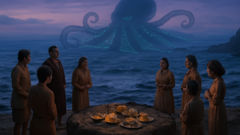Introduction
In the hollow of an island that remembers its first fires, where basalt cliffs meet reef and sky, the people of the Cook Islands whisper the name Kave with the same reverence given to storms and births. Not merely a creature of the deep, Kave is first and last a presence woven into the islands’ memory: eight-armed, ink-dark, the hinge between surface light and the world beneath. Fishermen leave offerings at low tide, chiefs consult dream-surfaced omens, and mothers hum lullabies that fold grandchildren into the ocean’s promise. There is a duality in every telling. To some Kave is a guardian who ferries lost ancestors and returns the righted balance of tides; to others Kave is the underworld’s stern keeper, pulling those who trespass into caverns where the sea keeps its ancient ledger. The legend stretches across lagoons and caves, across voyaging canoes and the hearth fires of small villages. It speaks of delimiters: the reef-line that marks safe water from the deep that takes names, the cave-mouth that opens to a realm where time slows and stones hold voices. In every version of the story, the world is alive and listening. The language the islanders use for Kave is thick with salt and caution; they shape tales so that the god’s temper is balanced against a compassion that remembers every lost child of the sea. This story gathers those voices, the island’s wind, and the steady pulse of tide-swinging moons, to tell of Kave’s origins, of pilgrimages to his cavern-throne, of bargains struck under the coral arches, and of the rituals that keep the living from being taken by what they revere. It is a story of the Cook Islands’ relationship with the ocean: its gifts, its debts, and the way communities find language to live with forces larger than their own making.
Origins in Basalt and Salt
The beginning of Kave’s story is told in the cadence of tides. Elders start on the shore, pointing to the teeth of the reef and to fissures in volcanic rock that look like the mouths of sleeping beasts, and they say that Kave was born of the first deepwater tears that cooled on lava. The island itself was hot with newness; the sea that folded up to its feet was older and had its own memory. Kave rose from that memory like an answer, part creature, part deity, a being grown large enough to hold more than hunger: memory, boundary, debt, and law.

According to one old narration recited at the cooking fires, an ancestor named Tangiaro had been the first to sail with a hollow log canoe between islands. On a night of odd stillness the sea opened and let Kave’s arm ripple against the canoe. It was not a violent greeting but a test—Tangiaro had offered neither food nor song. He learned to balance his offerings against his needs; he learned that the sea would not be taken from, only invited into. From that pact came the first rituals: small shells threaded with pandanus leaves left at low tide, songs hummed while mending nets, and a taboo against taking too many fish from a single spit of reef. Those taboos became laws of living and ensured the islanders’ survival in lean seasons.
Kave’s physical image grew in the telling—a massive cephalopod with eyes like polished lagoon stones, suckers that could read the names of the dead pressed into bone, and limbs that could both cradle a canoe and pull it under. Perhaps the most famous element was Kave’s cave, a black mouth in the reef known to leaders as the Hira Cave, which was said to open to an underworld of coral columns where the currents spoke in voices. To visit the cave was to cross into a place where ancestors resided. Those who passed through Kave’s realm returned changed: they spoke of seeing the ocean’s ledger, of currents that kept track of promises and debts, and of a hush that demanded respect rather than supplication.
As people told it on nights when breadfruit smoke lay low, Kave’s dominion was not only the bottomless dark. He governed transitions—the crossing from life to death, the movement between abundance and famine, the time when canoes returned with nets full or empty. In some versions Kave is an adjudicator, weighting a person’s life like a tide; in others he is a guardian, ferrying souls to where the sea remembers their names. Communities built their calendars around such beliefs, aligning offerings with moon cycles, and creating days when the sea was propitiated with woven mats and boiled fish. These traditions made Kave both a cosmic figure and a daily presence.
The legend of Kave also held warnings. There are stories of children who strayed too close to the reef at night and found themselves followed by a shadow that was not a fish. There are accounts of chiefs who sought Kave’s favor through arrogance and were answered with whirlpools that swallowed canoes whole. Respect was never merely about ritual—it was a practical mutuality. The people learned to read Kave’s moods in the stain of the sky at dawn, the pattern of broken shells, the direction of drifting weeds. They taught their children that the sea’s generosity could be exhausted; that every living thing belonged to a larger account book that Kave kept. That ledger was not cold justice but a remembering, an insistence that actions had a return.
In the mythic balance, Kave’s actions were often subtle. Rather than striking with an angry wave, he might remove a favored reef fish until the islanders remembered to give thanks. He might bring a storm if a chief broke a sacred rule. Yet he also gifted: surf-lines that carried voyagers home, sudden schools of fish that fed an island through a drought, and the quiet of a night when the dead could be named without grief tearing open the living. The legends teach that to live by Kave’s eyes is to be mindful of relationship, scarcity, and reciprocity.
There is also a deeper thread—Kave as keeper of names. In several tales Kave’s suckers are said to read names carved in bone or whispered into clam shells and to keep those names in the caverns. The underworld is less a place of punishment than a repository of story; the ocean remembers what the land forgets. For islanders, remembering a name in the right way kept the spirit whole; forgetting it could invite loss. This belief shaped funerary rites and even agriculture: crops were planted after rites to ancestors to ensure that the living were not severed from those who had gone before.
Over time, different villages claimed different aspects of Kave. In one southern atoll he was a stern ferry-man; in another he was a cunning negotiator who loved riddles. Yet the core motif remained the same: Kave connected the living to the sea’s deeper law. His presence taught humility, patience, and care. Even today, when modern boats hum and the islanders carry radios, the cadence of old stories persists. They surface in the way a fisherman ties his line, in lullabies to infants, and in the hush visited upon a community before a ritual night. The myth remains a living conversation between the islands and their ocean, carried forward in the breath of those who still measure life by the turning of tides.
Rites, Bargains, and the Living Sea
Ritual in the Cook Islands is not mere ceremony; it is negotiation, calibration, and sometimes a desperate rewriting of a ledger. The rites surrounding Kave are shaped by those human needs—repairing damage, asking favors, and renaming grief as a form of continuity. The island priests, or those who held the role of mediators between water and hearth, carried a language of gestures and small acts: a handful of crushed coral here, a steamed fish there, songs that braided memory into motion. These rites served a practical and spiritual function: they kept the community bound to its resource, and they kept Kave’s memory alive in ways that angers would not erase.

On nights when the moon hung thin and the air smelled of salt and roasted root, people gathered at the reef’s edge to perform the smallest of bargains. The eldest of the village would place an offering on a flat stone at low tide—often a mat, some pearls of shell, a piece of tapa cloth, or a child's hair braided into a small knot. The proceedings were modest. A song rose, voices soft enough not to disturb the sleeping fish, calling by name the ancestors and petitioning Kave for mercy or bounty. The petition was precise: it spoke of the number of fish needed, the child’s name, a request that no storm be made to swallow boats, a plea that the reef bear its load until new coral grew. The islanders believed Kave heard the precision in the rites and answered accordingly. That precision marks the difference in these myths between bargaining with gods and proclamation to indifferent nature; Kave listened like a ledger that wanted exactness.
One of the most famous bargains recorded by storytellers involves a chief named Meretoa, whose people faced starvation when the reef failed to yield. Desperation led Meretoa to seek the Hira Cave and call Kave’s name until the water trembled. Inside the cave she offered not just food but her own voice: she promised to sing the island's history each evening to remind the sea of its debts to human memory. Kave accepted, not because he needed sound, but because the reciprocal act of remembering was itself an offering. The tide returned with fish, and Meretoa’s children learned new songs that stitched the past to the present. That bargain teaches that cultural labor—ritual, song, song-making—counts as payment in this mythic economy.
There were also darker bargains. The legend catalogs times when grief became a doorway for bargaining gone wrong. A family, bereft of a child lost at sea, might attempt to call Kave’s mercy through forbidden rites. Such rites invited danger: the underworld answered, but not as expected. The bargain’s terms could be misread by haste and grief, and Kave’s justice is precise rather than sentimental. To try to circumvent death by bargaining with measures that break taboo was to invite a return that would unsettle the village’s balance—storms, disease in crops, or nets that came back empty. Those cautionary tales codified taboos into communal laws. They also made the legend a teaching tool, a way of showing how grief requires communal support rather than solitary bargains with cosmic powers.
Two images recur in many accounts: the canoe and the cave. Canoes that crossed for trade or challenge were blessed before departure; a small offering tied to the prow meant the difference between rescue and vanish. The cave, by contrast, required guiding words and a calm heart. Priests who entered the cave did so often in pairs, because the underworld’s currents could twist the mind like eddies twist a leaf. They carried nothing heavy; they carried songs and the names of those they represented, and they had net-baskets for whatever Kave might permit them to bring. When they came back to the light, their hands often smelled of the deep salt and of coral dust, and their eyes seemed to hold an ancient slow patience.
The story of Kave’s interactions with chiefs and priests also touches governance. Chiefs were expected to adjudicate with the sea’s knowledge in mind, meaning leaders who ignored the reefs and made plundering decisions faced the sea’s correction. Some leaders claimed monopolies on favored reef spots until Kave made scarcity speak; fish vanished from reefs where greed grew, rediscovered only when the community redistributed harvest. In this way the legend underpinned social norms about stewardship, and the notion of common resource and taboo fed into governance through story.
Kave’s presence was also woven into daily life in subtler ways. Women who wove mats often dedicated the first square to the sea, trimming and knotting with the rhythm of tides. Boys learning to fish were taught through repetition to respect the reef-line; in that training the reef became an oral tutor fashioned from rock and coral. Lullabies named Kave as a kindly midwife for children who dreamt of fish and waves; they taught small lessons about timing and patience. The sea, in the popular imagination, was not merely a provider but a relationship partner whose moods reflected how well the human side kept its promises.
Finally, the legend of Kave adapts. As islands modernized, as aluminum boats and new fishing methods appeared, storytellers adjusted the tales to include these changes. In one recent retelling a Kave is seen circling a motorized boat, not to punish but to warn: the new nets could empty the reef so fast it could not recover. The moral arc holds — Kave provokes a communal rethinking of practice. The myth remains flexible enough to speak to environmental change as much as to loss and lineage. It teaches a practical ethic: that the ocean is a living ledger, and to live sustainably is to keep the ledger balanced. By making law intimate and myth material, the legend continues to shape how islanders conceive of their future and how they act to preserve both reef and story.
Conclusion
Kave’s legend persists because it is both a mirror and a map. It reflects the islanders’ fears—storms, loss, forgetting—and it maps a route for living among forces beyond ordinary control. The octopus god’s underworld is not simply a place of doom; it is a repository of names and promises, the sea’s ledger where debts are tracked and recompense is measured. Rituals and bargains are modes of conversation with that ledger: small acts of attention that keep tides from being cruel. For contemporary Cook Islands communities the story of Kave offers more than mythic color; it offers an ethic of reciprocity and careful use. In an age where reefs are stressed and oceans warm, the ancient voice that says, “Give back; remember; measure your needs against the whole,” has renewed currency. The legend teaches that stewardship is not a modern imposition but a continuation of relations always there—between people, reef, and the deep. To invoke Kave is to invoke responsibility: to treat the sea as kin, to sing the names of those who went before, and to leave offerings not as superstition but as acknowledgment of interdependence. When the wind takes the scent of pandanus and the tide draws its line, the people still listen for the low answering of the deep. Kave’s shadow passes beneath the canoe and the child, and through stories told at dusk his law continues to be learned. The legend does not end; it gathers—across generations, across changing tools and weather—an account of how an island people remain in relation with a vast and living sea.













